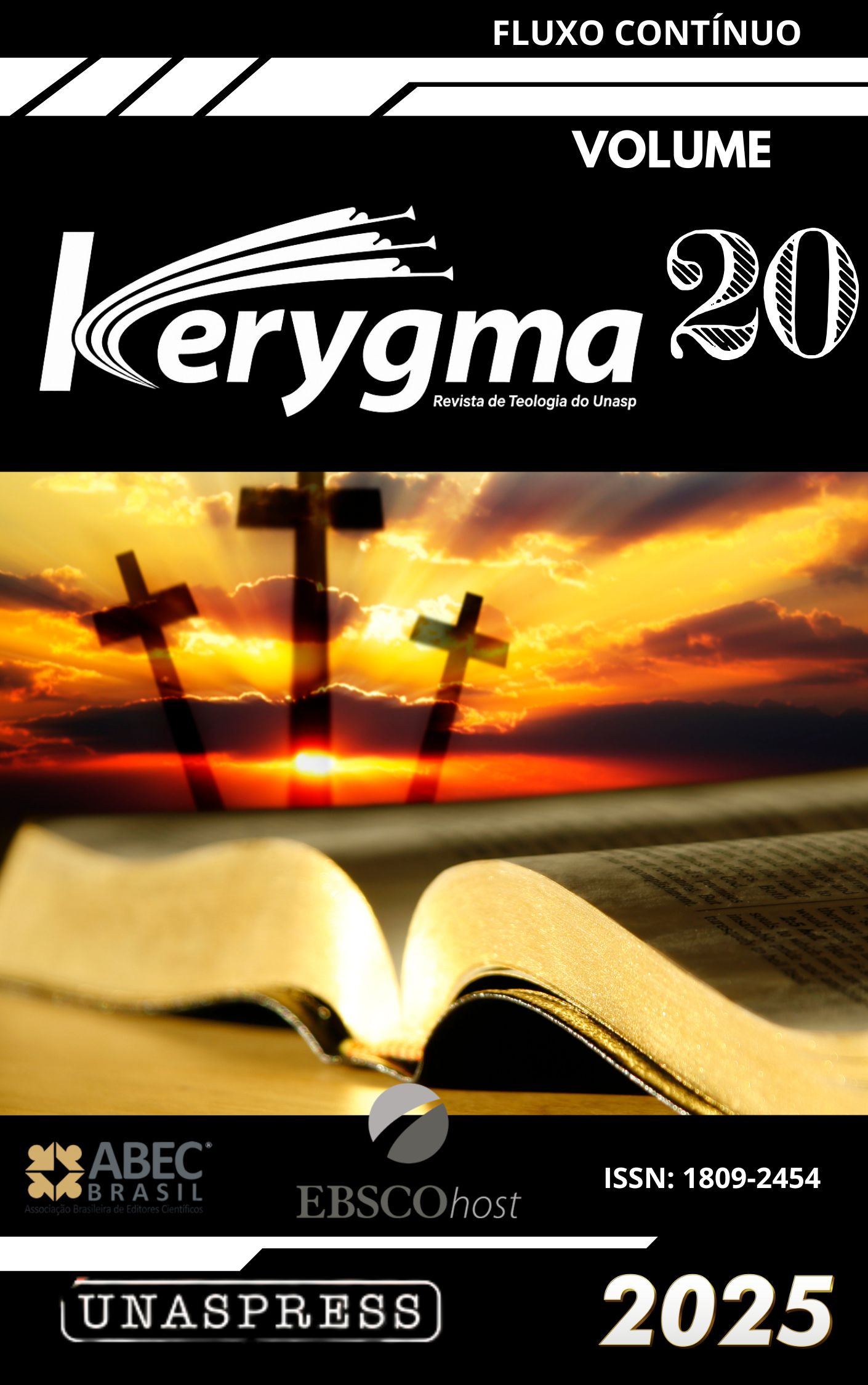Resumo
Os intérpretes em geral consideram que a Babilônia é lembrada por Deus no transcurso da sétima taça da ira (cf. Ap 16:19). Após isso, então, Deus derramaria sobre ela a sua ira. No entanto, segundo Apocalipse 15:1 e 16:17, a ira de Deus é completamente satisfeita ao longo das seis primeiras taças e ao derramar da sétima “pelo ar”. Antes mesmo das teofanias da sétima taça, Deus se declara satisfeito com a execução de seus juízos, com a declaração “Feito está!” (Ap 16:17). Além disso, na leitura mais corrente dessa unidade textual, Deus teria se lembrado da Babilônia para lhe dar o cálice da ira após a “grande cidade” se dividir em três partes, ou ser de todo destruída, o que sugeriria um anacronismo nessa seção (Ap 16:17-21). Questões de estrutura e aspectos linguísticos devem ser analisados a fim de se esclarecer o sentido da visão de Apocalipse 17 após as sete pragas, e que relação esse relato mantém com a visão das sete pragas (Ap 16). Este artigo emprega uma metodologia exegética com análise estrutural na busca de mais respostas para estas questões. A hipótese defendida aqui é de que Apocalipse 17 não relata um evento posterior nem um desdobramento da sétima taça, mas uma explicação das pragas quinta e sexta.Referências
AUNE, D. E. Revelation 1-5. Dallas, TX: Word, 1997. (Word Biblical Commentary, v. 52a).
AUNE, D. E. Revelation 6-16. Nashville, TN: Thomas Nelson, 1998. (Word Biblical Commentary, v. 52b).
BEALE, G. K. The book of Revelation. Grand Rapids, MI: Eerdmans, 1999. (The New International Greek Testament Commentary).
BROWN, C. (ed.). The new international dictionary of the New Testament theology. V. 2. Grand Rapids, MI: Zondervan, 1978.
COLLINS, A. Y. The combat myth in the book of Revelation. Eugene, OR: Wipf and Stock Publishers, 2001.
CUSTER, S. From Patmos to paradise: a commentary on Revelation. Greenville, SC: BJU Press, 2004.
DORNELES, V. Adorai aquele que fez: a narrativa da criação e o clímax do grande conflito em Apocalipse 12 a 14. Revista Criacionista Brasileira, n. 100, 2019, p. 6-21.
FARRER, A. A rebirth of images: the making of St. John Apocalypse. Nova York: State University of New York Press, 1986.
FIORENZA, E. S. The book of Revelation: justice and judgment. Mineápolis, MN: Fortress, 1998.
JOHNSON, A. F. Revelation. In: GAEBELEIN, F. E. (ed.). The Expositor’s Bible Commentary. Grand Rapids, MI: Zondervan, 1981. v. 12.
KISTEMAKER, S. J. Revelation. Grand Rapids, MI: Baker Academic, 2001. (New Testament Commentary).
KOESTER, C. R. Revelation: a new translation with introduction and commentary. New Heaven, CT: Yale University Press, 2014. (The Anchor Yale Bible).
KRODEL, G. A. Revelation. Minneapolis, MN: Augsburg Publishing House, 1989. (Augsburg Commentary on the New Testament).
LARONDELLE, H. K. Armageddon: sixth and seventh plagues. In: HOLBROOK, F. B. (ed.). Symposium on Revelation, book 2: exegetical and general studies. Silver Spring, MD: Biblical Research Institute, 1992, p. 373-390. (Daniel and Revelation Committee Series).
LARONDELLE, H. K. Chariots of salvation: the biblical drama of Armageddon. Hagerstown, MD: Review and Herald, 1987.
LÉVI-STRAUSS, C. The structural study of myth. The Journal of American Folklore, v. 68, n. 270, p. 428-44, 1955.
METZGER, B. Breaking the code: understanding the book of Revelation. Nashville, TN: Abingdon, 1993.
MICHAELS, J. R. Interpreting the book of Revelation. Grand Rapids, MI: Baker, 1992.
MOUNCE, R. H. The book of Revelation. ed. rev. Grand Rapids, MI: Eerdmans, 1977. (The New International Commentary on the New Testament).
MUELLER, E. When the prophecy repeats itself: recapitulation in Revelation. Silver Spring, MD: Biblical Research Institute, 2015. (Biblical Research Institute Release, v. 14).
MURPHY, F. J. Fallen is Babylon: the Revelation to John. Harrisburg, PA: Trinity Press, 1998.
NICHOL, F. D. (ed.). Comentário bíblico adventista do sétimo dia. Tatuí, SP: Casa Publicadora Brasileira, 2014.
OSBORNE, G. Revelation. Grand Rapids, MI: Baker Academic, 2002. (Baker Exegetical Commentary on the New Testament).
PAULIEN, J. Armageddon at the door. Hagerstown, MD: Review and Herald, 2008.
PAULIEN, J. Decoding Revelation’s trumpets: literary allusions and the interpretation of Revelation 8:7-12. Berrien Springs, MI: Andrews University Press, 1988. (Andrews University Seminary Doctoral Dissertation Series, v. 11).
RICOEUR, P. The symbolism of evil. Boston: Beacon, 1963.
ROTZ, C. Revelation: a commentary in the New Testament. Kansas, AK: Beacon Hill Press, 2012.
SMALLEY, S. S. The Revelation of John: a commentary on the Greek text of the Apocalypse. Downers Grove, IL: InterVarsity, 2005.
STEFANOVIC, R. Revelation of Jesus Christ: commentary on the book of Revelation. 2. ed. Berrien Springs, MI: Andrews University Press, 2009.
THOMAS, J. C. The Apocalypse: a literary and theological commentary. Cleveland, TN: CPT Press, 2012.
WELLCOME, I. C. History of the second advent message and mission, doctrine and people. Yarmouth, ME: I. C. Wellcome, 1874.
WHITE, E. G. Notes of travel. Review and Herald, 25 nov. 1884.
WHITE, E. G. O grande conflito. 42. ed. Tatuí, SP: Casa Publicadora Brasileira, 2004.

Este trabalho está licenciado sob uma licença Creative Commons Attribution 4.0 International License.
Copyright (c) 2025 Kerygma





